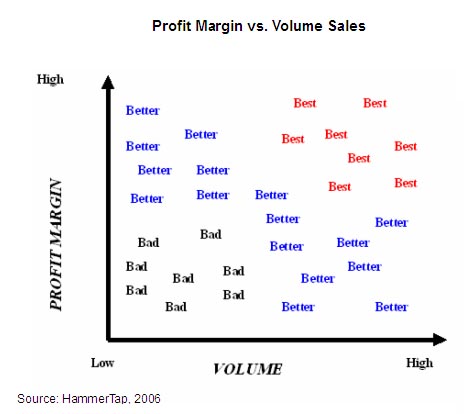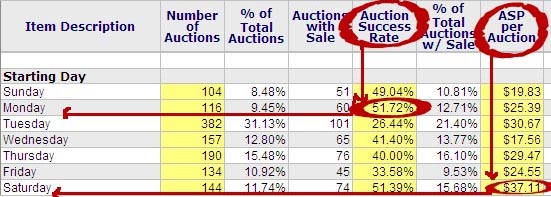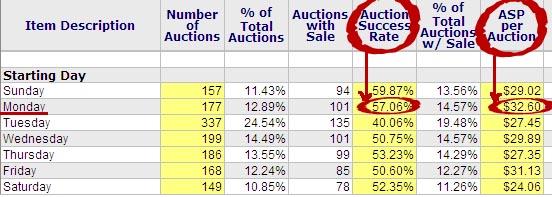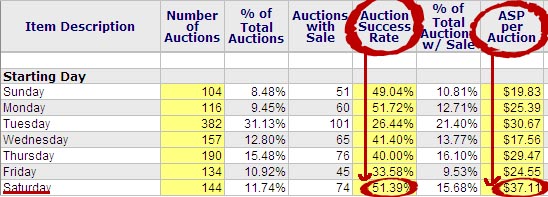 |
 |
 |
Discovering Ideal eBay Listing Combinations
By Steve Nye, eBay Certified Consultant and Research Education Specialist Years ago, while packing for a trip I ran into quite a dilemma. I hadn’t used my suitcase for a while and I forgot the simple 3-digit combination. After some early panic and frustration I decided I would just have to “crack the code” on my own! I sat in front of the television and began to methodically try different options.. “000”, “001” , “002”... you get the picture. I was pleasantly surprised that after only 35 minutes of trying random combinations, I cracked the code. It was “305”, which happened to be my apartment number. eBay Listing Complexity... CrackedOn eBay, we’re doing kind of the same thing. We seek the key to finding a buyer for every listing who is willing to pay the very highest price for each item we sell. If only we knew how to “crack the code”. That’s where auction research comes in. Right now, the eBay community is buzzing about “eBay market research.” What’s all the talk about? Make Your Own LuckHere’s what it comes down to: selling more listings and getting higher selling prices is not just “good luck.” With the right tools and data, your success is predictable. There are always reasons why one listing performs well while others fail. Factors for success or failure include:
The fact is that it’s really a combination of all those things. To make the most money on eBay you have to “crack the code”. Successful CombinationsEven with trial and error, what are the chances that you are going to come up with the optimal combination of listing strategies for your auctions? Thankfully my suitcase had a combination with only 3 digits, which meant there were only 1000 different possible combinations. But that’s just three numbers. That is a piece of cake next to the possible combinations of listing elements for eBay auctions where the number of combinations is astounding. Multiply possible closing days, times possible auction types, times listing features, times categories, times products, times styles and brands, … Well, you begin to get the picture. Each new digit adds an exponential increase in possible solutions. So how do you know the optimal combination of elements that will produce the best possible chance of selling a higher volume or give you the best possible price? No More GuessworkTrial and error works eventually. Those of you who have been selling for a while could teach us a few things about how to sell a product you’ve been selling for a long time, right? But, if you want to learn from the competition’s experience, and you want to learn quickly, you need eBay market research. eBay market research helps you crack the code. Vendors selling new products rarely have information that allows them to know real customer needs when listing an item. Simply stated: Most vendors don’t know what is driving customer purchasing!!!!! Each seller needs information that can target those buyers that will help them meet their full profit potential… make the most money! Measures of eBay Success1. What listing attributes matter most to sellers focused on sales volume? They are probably those auction attributes that influence a buyer to make a quick purchase decision. 2. What listing attributes matter most to sellers focused on profit margin? They are probably those auction attributes that influence a buyer to make a high bid. Although the general answers to these two questions are a no-brainer, when you try to implement them in a real auction the task is more difficult. For example, can you tell me which auction features are most important to getting a high price for an item? What if the item changes? What if the time of year changes? I could go on forever with changes that could come about. If trial and error is your research tool, you’ve got a never ending, uphill battle of guesswork in front of you. When a product goes to market, its position is determined by several factors, two of the most important being profit margin and sales volume. The same holds true for eBay listings. Often an eBay seller will create a strategy based on one of two areas: either increasing profit, or increasing successful auctions. And these are both solid goals. Great eBay sellers however, understand that movement in both these areas is essential to generating the highest possible overall profit. The diagram below helps us visualize and understand that the best product placement is always in the top right corner, where both volume and profit margin are the highest.
The answer to this problem could be compared to âcracking a code;â while it may be very challenging, it is possible! Let’s use some actual market research to look at some eBay items. I have two old balls sitting in my garage that I want to sell, one is a football and the other is a basketball. Right now, I’d like you to make some guesses about ways to sell each item. First, let’s imagine that I need to make sure that my auctions sell quickly. I’m leaving on vacation and don’t have time to hang around waiting for a sale. What’s the best starting date for my auction? Does starting date really matter? Second, let’s imagine another scenario where I’ve got all the time in the world and I just want to make sure that I make the most money possible off my two items. What is the best starting date now? Again, could that really make any difference? When you’re guessing, I’d like you to pay attention to how confident you were when you guessed which the best start days in each scenario were. Remember, without auction research, you’re “guessing” all the time. In the last message, you guessed about starting dates for items with different auction goals in mind. Letâs take the easy route and look at what the research says. We can find the answers to these questions on the Research Report Index on DeepAnalysisâ Reports tab. Letâs look at football data first.
What we see is that it might be in my best interest to start my auction on Sunday if I am mostly concerned with having a successful sale. However, if I am concerned about getting the highest possible sales price (ASP) for my football I might want to start my auction on a Monday. What about my basketball? Again letâs look at the data and see what we find.
What we see is that with my basketball, it might be in my best interest to start my auction on Monday if I am mostly concerned with having a successful sale. However, if I am concerned about getting the highest possible sales price (ASP) for my basketball I might want to start this auction on a Saturday. Let’s sum up our findings. Football:
Basketball:
When you made your guesses earlier, were you right? An important point I want to make here is that, with good data research our confidence level in our choices goes way up because our decisions are based on factual data not trial and error or lucky guesswork. Now that I have the initial research to help me decide what day I should start my auction on to meet one of my two goals, Iâm ready to make a much more important decision. Up to this point I have been asking you to decide between two strategies: a better chance of selling or a higher price. Now, letâs try, instead, to maximize them both. So the question then becomes, what day should I start my auction on if I want to have the highest possible chance of a successful auction and at the same time maximize the final sales price? Remember the chart we posted earlier? In other words, what starting date will move me in towards the top right of our graph? The answers to each of these questions is different for every productâsometimes even for every brand! Iâll find the answers to my questions, once again, on the Reports tab in DeepAnalysis. Itâs clear that with my football, Monday is going to be the best day to give me the best chance of selling my ball and the best chance at getting a higher average sales price.
Itâs clear that with my basketball, Saturday is going to be the best day to give me the best chance of selling my ball and the best chance at getting a higher average sales price.
Would you have thought that there would be such a difference between two balls from my garage? Itâs important to remember here that these differences exist with every product listed on eBay and they change relative to every feature that you can choose from when you generate an auction on eBay. Again, letâs think about the âcodeâ we needed to crack. Today we used data research to quickly discover one digit of our code, auction start date. Although the process was quick and easy, we now will need to continue with a few other features (end date, reserve price, bolding, highlights, photos, etc.) so that we can have the entire code to higher eBay profits revealed completely. Once the process is complete we can sell with confidence that comes from knowing that guesswork has been eliminated and that our decisions are instead based on actual data. Itâs my hope that after todayâs discussion we all understand that quality research software tools, like DeepAnalysis, can help you decide the best time of day to end your auction, the best auction duration, the best starting price, categories and title words that will bring more buyers, and lots more. With practice, youâll discover all kinds of treasuresâand not just the ones in your garage. Make the most of your auctions with research!Try HammerTap FREE for 10 Days and remove the guesswork!Determining what works and what doesn't when it comes to your listings requires research. Anything less puts you at risk of not making the sale or not making as much as you could be on each sale. A research tool like HammerTap helps you bypass the costly trial and error process by quickly giving you the key information you need for profitable online auctions. Why not take HammerTap for a FREE test drive? We'll give you 10 days to put HammerTap to work for you. Use its power to determine:
As a bonus, you'll receive 10-lesson Power to Profit course to help you immediately see the effects research can have on your auctions. We'll also throw in selling tips from Industry Experts in our members-only Auctionography newsletter. You owe it to yourself to take the guesswork and risk out of your auctions. Try HammerTap free for 10 days. If you are not absolutely sure you'll increase your eBay profits by the $19.95 subscription price, you're free to cancel. It costs you nothing to prove to yourself there's a more profitable way to eBay. Click HERE to See How HammerTap Gives You the Power to Profit |
|||||




